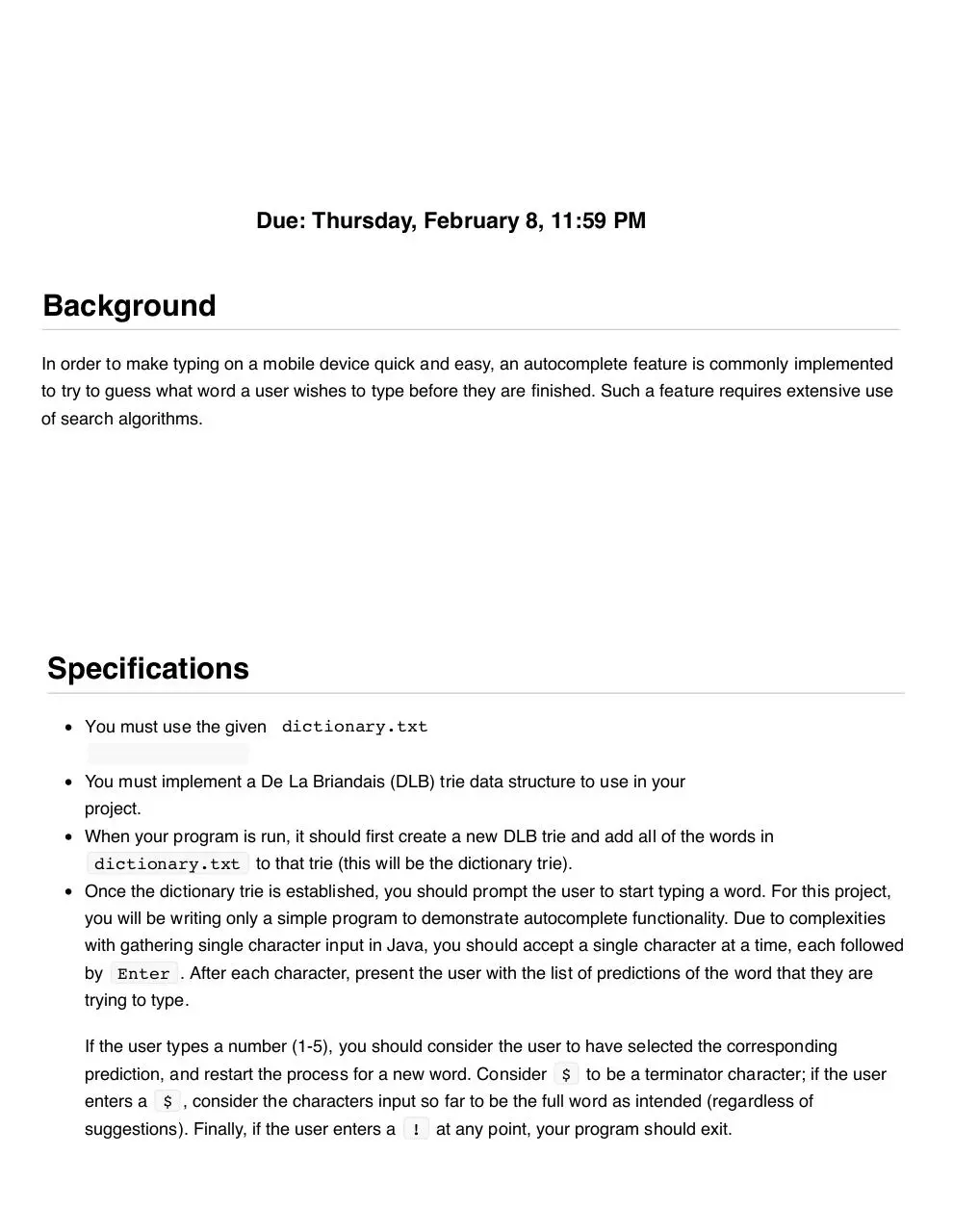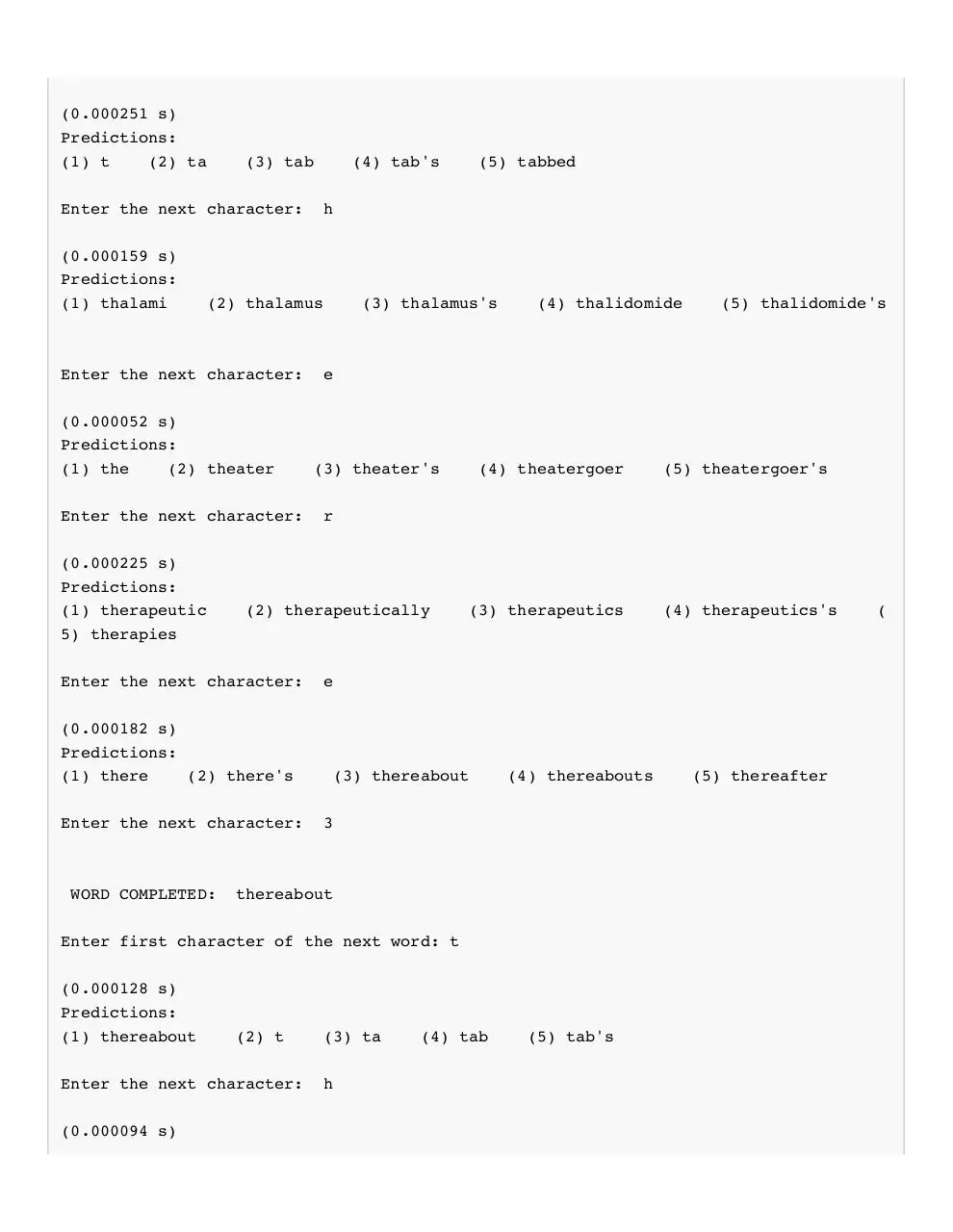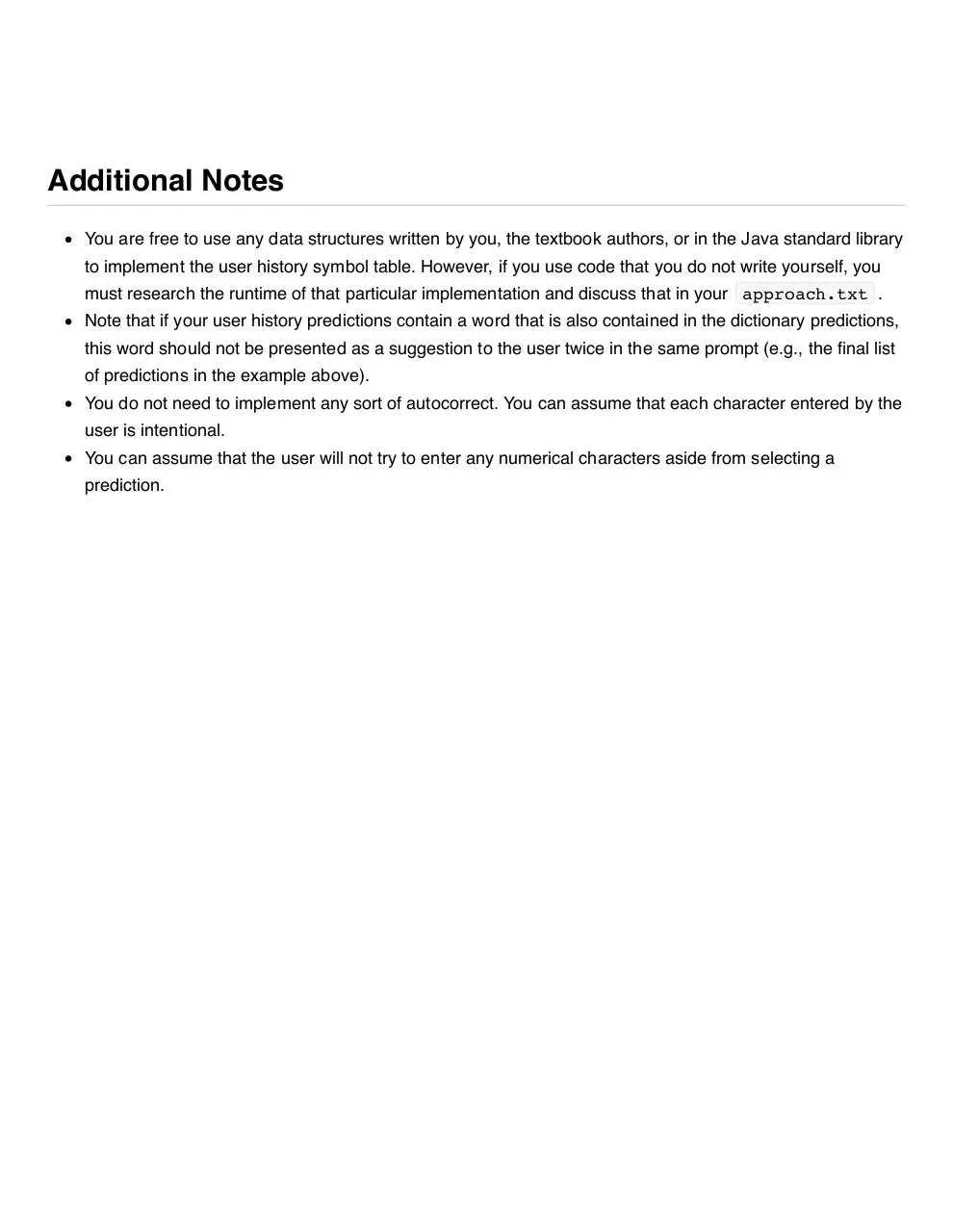P1 Instructions (PDF)
File information
Title: P1 Instructions
This PDF 1.3 document has been generated by MacDown / Mac OS X 10.13.2 Quartz PDFContext, and has been sent on pdf-archive.com on 26/01/2018 at 20:22, from IP address 24.3.x.x.
The current document download page has been viewed 172 times.
File size: 56.27 KB (5 pages).
Privacy: public file





File preview
Due: Thursday, February 8, 11:59 PM
Background
In order to make typing on a mobile device quick and easy, an autocomplete feature is commonly implemented
to try to guess what word a user wishes to type before they are finished. Such a feature requires extensive use
of search algorithms.
Specifications
You must use the given dictionary.txt
You must implement a De La Briandais (DLB) trie data structure to use in your
project.
When your program is run, it should first create a new DLB trie and add all of the words in
dictionary.txt to that trie (this will be the dictionary trie).
Once the dictionary trie is established, you should prompt the user to start typing a word. For this project,
you will be writing only a simple program to demonstrate autocomplete functionality. Due to complexities
with gathering single character input in Java, you should accept a single character at a time, each followed
by Enter . After each character, present the user with the list of predictions of the word that they are
trying to type.
If the user types a number (1-5), you should consider the user to have selected the corresponding
prediction, and restart the process for a new word. Consider $ to be a terminator character; if the user
enters a $ , consider the characters input so far to be the full word as intended (regardless of
suggestions). Finally, if the user enters a ! at any point, your program should exit.
To generate the list of predictions, your program should not only consult the dictionary trie, but also keep
track of what words the user has entered in the past. If the user has previously entered the same
sequence of characters as a prefix to a word, you should prioritize the words that most frequently resulted
from this sequence previously. If the user has never entered the current sequence before, or has entered
fewer than 5 words with the current sequence as a prefix (i.e., not enough words to complete the list of 5
predictions), your program should suggest words from dictionary.txt that have the current
sequence as a prefix.
You program should propose at most 5 suggestions at a time. If there are fewer than 5 suggestions
available from the user’s history and the dictionary trie combined, then only print out the available
suggestions.
If the current sequence of characters has not been entered by the user before and does not appear in
dictionary.txt , you should display a message to the user stating that no predicions were found,
and allow the user to continue entering characters one at a time. Once the user enters a $ , you should
consider the word to be finished and add it to the user’s history so that you can predict it in the future.
Your program should run in a case sensitive manner in order to allow for easier prediction of proper nouns
and acronyms.
The design of the data structure that keeps track of a user’s previously entered words is entirely up to you.
You must create a file named approach.txt that both describes your approach to implementing this
symbol table and justifies your decision to take this approach.
The history of the user’s entered words should persist across runs of your program. To enable this, your
program should save a representation of this data structure to the file user_history.txt before
exiting.
Each time the user enters a character, you should use Java’s System.nanoTime() to calculate how
long your program takes to find the predictions. You should display this time along with the list of
predictions.
After the user enters ! , your program should output the average time that was required to produce a list
of predictions.
An example run of the program would proceed as follows:
Enter your first character: t
(0.000251 s)
Predictions:
(1) t
(2) ta
(3) tab
(4) tab's
Enter the next character:
(0.000159 s)
Predictions:
(1) thalami
h
(2) thalamus
Enter the next character:
(0.000052 s)
Predictions:
(1) the
(2) theater
Enter the next character:
(0.000225 s)
Predictions:
(1) therapeutic
5) therapies
(3) thalamus's
(3) theater's
WORD COMPLETED:
(4) theatergoer
(3) therapeutics
(3) thereabout
(4) thereabouts
3
thereabout
(2) t
Enter the next character:
(0.000094 s)
(5) theatergoer's
(4) therapeutics's
e
Enter first character of the next word: t
(0.000128 s)
Predictions:
(1) thereabout
(5) thalidomide's
r
(0.000182 s)
Predictions:
(1) there
(2) there's
Enter the next character:
(4) thalidomide
e
(2) therapeutically
Enter the next character:
(5) tabbed
(3) ta
h
(4) tab
(5) tab's
(5) thereafter
(
Predictions:
(1) thereabout
(2) thalami
Enter the next character:
(0.000085 s)
Predictions:
(1) thereabout
(0.000145 s)
Predictions:
(1) thereabout
herapeutics's
(0.000130 s)
Predictions:
(1) thereabout
(5) thalidomide
(4) theater's
(5) theatergoer
r
(3) therapeutically
(4) therapeutics
e
(2) there
Enter the next character:
Average time:
Bye!
(3) theater
(2) therapeutic
Enter the next character:
(4) thalamus's
e
(2) the
Enter the next character:
(3) thalamus
(3) there's
(4) thereabouts
(5) thereafter
!
0.000145 s
You must name your main program file ac_test.java .
You must be able to compile your program by running javac ac_test.java .
You must be able to run your program by running java ac_test .
(5) t
Additional Notes
You are free to use any data structures written by you, the textbook authors, or in the Java standard library
to implement the user history symbol table. However, if you use code that you do not write yourself, you
must research the runtime of that particular implementation and discuss that in your approach.txt .
Note that if your user history predictions contain a word that is also contained in the dictionary predictions,
this word should not be presented as a suggestion to the user twice in the same prompt (e.g., the final list
of predictions in the example above).
You do not need to implement any sort of autocorrect. You can assume that each character entered by the
user is intentional.
You can assume that the user will not try to enter any numerical characters aside from selecting a
prediction.
Download P1 Instructions
P1_Instructions.pdf (PDF, 56.27 KB)
Download PDF
Share this file on social networks
Link to this page
Permanent link
Use the permanent link to the download page to share your document on Facebook, Twitter, LinkedIn, or directly with a contact by e-Mail, Messenger, Whatsapp, Line..
Short link
Use the short link to share your document on Twitter or by text message (SMS)
HTML Code
Copy the following HTML code to share your document on a Website or Blog
QR Code to this page

This file has been shared publicly by a user of PDF Archive.
Document ID: 0000726717.